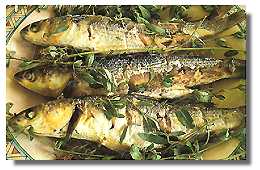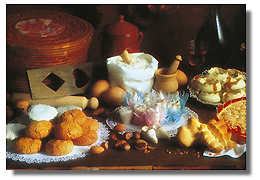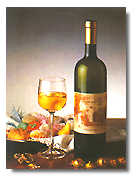
The varieties of fish that Sardinians prefer roasted over coals are: orate (gilthead bream),
mormore (striped bream), spigole (sea bass), triglie (red mullet),
muggini (gray mullet), and anguille (eel). Aragosta (lobster), gamberi
(shrimp), vongole (clams), and seppiette (tiny squid) are used in all sorts of pasta
and rice dishes.
The shepherd's ancient tradition has led to the production of many different types
of cheese now produced in modern factories. Among the most wellknown is the popular
fiore sardo or pecorino sardo, a firm cheese made from fresh, whole sheep's milk
and lamb or kid rennet. Pecorino romano is a drier, sharp cheese made with boiled steep's
milk and lamb rennet. Dolce sardo is a softer, cow's milk cheese. A singular cheese, unlikely
to appeal to the tourist, is casu marzu (literally, "rotten cheese"). It is produced when tiny white larva form in the cheese,
gradually reducing it to a creamy consistency. The taste is said to be both delicate
and piquant. Casu marzu is not sold commercially but is still made privately for home use.

There is a wide array of sweets. Sebadas are fried ravioli-like pastries of fresh cheese,
covered with honey. Pardulas are little pastry "baskets" of sweetened farmer's cheese.
Bianchittus are crisp white meringues. Pistoccheddus, pirichittus, and papassinas
are made with flour, eggs and sugar, the latter with the addition of raisins. Almonds are the main
ingredient in amarettus, gueffus, candelaus, and sospirus.
Many red and white table wines (Nuragus, Barbera, Cannonau, and Moscato) are produced
in the Campidano and others make excellent aperitif wines (Vermentino and Vernaccia).
Two characteristic alcoholic beverages made in Sardinia are mirto, flavored with native
myrtle berries, and su fil'e ferru, distilled from the grape dregs left over from winemaking.
The latter name derives from the long-ago habit of sticking a wire (su fil) made of iron (ferru) into
the ground to mark the liquor's underground hiding place.
Restaurants
|







